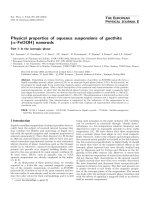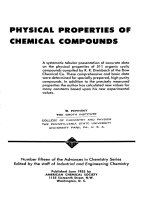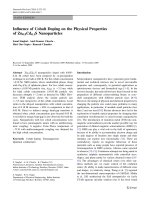Characteristic physical properties of B-doped germanene nanoribbons: A DFT study
Bạn đang xem bản rút gọn của tài liệu. Xem và tải ngay bản đầy đủ của tài liệu tại đây (1.21 MB, 9 trang )
TNU Journal of Science and Technology
227(15): 75 - 83
CHARACTERISTIC PHYSICAL PROPERTIES OF B-DOPED GERMANENE
NANORIBBONS: A DFT STUDY
Hoang Van Ngoc1*, Trieu Quynh Trang2
1
Institute of Applied Technology, Thu Dau Mot University
Nam Dinh Teacher Training's College
2
ARTICLE INFO
Received:
01/8/2022
Revised:
16/9/2022
Published:
16/9/2022
KEYWORDS
Germanene nanoribbons
Boron doping
Doping configuration
Configurations
One-dimensional material
ABSTRACT
This work studies one-dimensional germanene materials (germanene
nanoribbons (GeNRs)) when doped with B atoms. The doped structure
and electromagnetic properties of the pre-and post-doping systems will
be studied and investigated. There are two doping ratios studied,
B:Ge=1:2 and B:Ge=1:3. With the four configurations studied, the
configurations are stable and retain the hexagonal honeycomb structure
after doping. The theory used for research is density functional theory
(DFT), combined with VASP software to simulate materials on a highperformance computer system. Research has shown that configuration
1-2(2) has a band gap extended to 0.585eV, thus this configuration has
potential application in room temperature field transistors. The s-p
multi-orbital hybridization, charge distribution, and displacement in the
doped configurations will also be studied in detail. The research opens
up future applications in the fields of nanoelectronics and
semiconductor technology.
CÁC TÍNH CHẤT VẬT LÝ ĐẶC TRƯNG CỦA CÁC BĂNG NANO GERMANENE
MỘT CHIỀU ĐƯỢC PHA TẠP B: MỘT NGHIÊN CỨU DFT
Hoàng Văn Ngọc1*, Triệu Quỳnh Trang2
1
Viện Phát triển Ứng dụng - Trường Đại học Thủ Dầu Một
Trường Cao đẳng Sư phạm Nam Định
2
THÔNG TIN BÀI BÁO
Ngày nhận bài:
01/8/2022
Ngày hồn thiện:
16/9/2022
Ngày đăng:
16/9/2022
TỪ KHĨA
Germanene một chiều
Pha tạp boron
Cấu hình pha tạp
Các cấu hình
Vật liệu một chiều
TĨM TẮT
Cơng trình này nghiên cứu vật liệu germanene một chiều (băng nano
germanene (GeNRs)) khi được pha tạp các nguyên tử B. Cấu trúc và
đặc tính điện từ của hệ trước và sau pha tạp sẽ được nghiên cứu và khảo
sát. Có hai tỷ lệ pha tạp được nghiên cứu: B: Ge = 1: 2 và B: Ge = 1: 3.
Với bốn cấu hình được nghiên cứu, các cấu hình ổn định và giữ được
cấu trúc tổ ong lục giác sau khi pha tạp B. Lý thuyết được sử dụng để
nghiên cứu là lý thuyết phiếm hàm mật độ (DFT), kết hợp với phần
mềm VASP để mô phỏng vật liệu trên hệ thống máy tính hiệu năng cao.
Nghiên cứu đã chỉ ra rằng cấu hình 1-2 (2) có độ rộng vùng cấm mở
rộng đến 0,585eV, do đó cấu hình này có tiềm năng ứng dụng trong các
bóng bán dẫn trường ở nhiệt độ phịng. Sự lai hóa đa quỹ đạo s-p, sự
phân bố và dịch chuyển điện tích trong các cấu hình pha tạp cũng sẽ
được nghiên cứu chi tiết. Nghiên cứu mở ra các ứng dụng trong tương
lai trong lĩnh vực điện tử nano và công nghệ bán dẫn.
DOI: />*
Corresponding author. Email:
75
Email:
TNU Journal of Science and Technology
227(15): 75 - 83
1. Introduction
The role of science and nanotechnology cannot be denied, this technology creates compact
and sophisticated devices for human life. Low-dimensional materials have their own
characteristics and properties, and the size limitation causes their physical properties to change.
When the particle moves in three-dimensional space, the particle's energy is continuous, but
when the particle is confined, the particle's energy is interrupted. The best known twodimensional material is graphene with a honeycomb lattice formed from C atoms [1]. Graphene
is a two-dimensional material with flat structure, high electrical conductivity, high thermal
conductivity, high elasticity, high stiffness and flexibility [2] – [6]. Graphene rivals materials
such as silicene and germanene [7]. Silicene and germanene both have a hexagonal honeycomb
structure like graphene, the big difference being that their structure is not as flat as that of
graphene [8] – [11]. Studies on successful synthesis of germanene have been conducted since
2014, followed by other works synthesizing single-layer germanene with a thickness of one atom
[12] – [15]. Both graphene, germanene and silicene share many similar characteristics, ranging
from s, px, py, pz multi-orbital hybridizations to other electronic properties. The electrons in the
Brillouin region, near the K, K' points, act as massless relativistic particles [16]. The structural
and electronic properties of germanene have been extensively studied using first principle
calculations [17] – [23]. DFT calculations have shown that the buckling of germanene is in the
range of 0.64-0.74Å [22], the reason for such a difference is that different calculation schemes
will give different values. The one-dimensional structures of germanene are called germanene
nanoribbons (GeNRs), and the size restriction gives rise to very different structural properties and
properties of GeNRs compared with two-dimensional systems [24], [25]. The appearance of
modified hydrogen atoms at the two edges of GeNRs has given rise to a small band gap, the
purpose of doping foreign atoms into GeNRs to expand its band gap and create substances that
can be applied. used under specific conditions [11], [26]. In this work, B atoms will be doped in
GeNRs with two ratios B:Ge=1:2 and B:Ge=1:3. The electromagnetic properties of the pre- and
post-doping systems will be studied and compared to find out the differences.
2. Methods
Using density functional theory (DFT) combined with VASP software to simulate the
electromagnetic properties of materials before and after doping. VASP software will be used on a
high-performance computer system to simulate the physical and chemical processes that take
place when doping B into GeNRs. The stability as well as the structural properties of the system
will be found in the output files of the VASP.
The split point grid in the KPOINTS files will be set at 1 1 11, after optimization, the split points
will be increased to 1 1 100 to calculate the energy band structure and state density of the system.
The cutoff energy during the study was set at 500eV. The Projector-Augmented Wave (PAW)
pseudopotentials is used to describe the interaction potentials on the electrons in the system.
3. Geometric structure
The unit-cell configuration of the pristine system (Figure 1a) and the doped systems (Figure 1be) shows the position of the substitution doped B atoms (green atoms) in the GeNRs system. Figure
1b and Figure 1c correspond to the doping ratio B:Ge=1:2; Figure 1d and Figure 1e correspond to
the doping ratio B:Ge=1:3. All doping configurations are stable and retain the honeycomb
hexagonal structure after optimization. The smallest formation energy corresponding to
configuration 1-2(2) is -1.74 eV (Table 1), this is the most optimal configuration among the studied
configurations. Comparing the Ge-Ge bond length between the configurations we see that the GeGe bond length in the 1-2(1) configuration is the largest (2.41 Å), and the Ge-Ge bond length in the
configuration Figure 1-2(2) is the smallest (2.36 Å). The partial bond length shows the interaction
76
Email:
227(15): 75 - 83
TNU Journal of Science and Technology
force between the atoms, the shorter the length, the stronger the bond between the atoms, so the
maximum bonding force between neighboring Ge atoms is shown in the 1-2(2) configuration.
Similarly, the bond length between Ge-B atoms in configurations 1-3(1) and 1-3(2) is the smallest
(1.99 Å), and the largest is for configurations 1-2(1) (2.09 Å), it shows that the B-Ge bond is the
most stable of the two configurations with the doping ratio B:Ge=1:3 (33.33%).
Figure 1. Unit cell of configurations: (a) Pristine; (b) 1-2(1); (c) 1-2(2); (d) 1-3(1); (e) 1-3(2)
The angle between two adjacent bonds indicates the structural flatness of the profiles. The
data in Table 1 show that the angle α of the doping ratio B:Ge=1:3 is the largest (119.99 o), which
proves that these configurations are almost flat after doping B. When compared with pristine
structure (α=109.32o), the angle α of all the doped configurations is larger than the alpha angle of
the original configuration, so it can be concluded that when doping B the structures become
flatter. The formation energy of the 1:2(2) configuration is the smallest (-1.74 eV), so it is the
most stable configuration [25]. The energy of formation depends on many factors including the
width of the nanoribbon and the atomic doping site. This formation energy is larger when
comparing Pt, Ag, Au, Sn, In doping in GeNR with width 7 atoms and 8 atoms [27].
Table 1. Geometric structure and the formation energy
Configurations
Percentage
Pristine
1:3(1)
1:3(2)
1:2(1)
1:2(2)
x
25%
25%
33.33%
33.33%
Ef (Formation
energy (eV))
x
-1.35
-1.24
-1.45
-1.74
Ge-Ge(Å)
Ge-B(Å)
α(Degree)
2.39
2.38
2.37
2.41
2.36
x
1.99
1.99
2.09
2.02
109.32
119.99
119.99
111.93
119.97
4. Electromagnetic properties
4.1. Energy band structure and multi-orbital hybridization
The bands of the pristine configuration do not cross the Fermi level (Figure 2a), indicating
that this is a semiconductor with a narrow band gap (0.23 eV). The energy gap depends on the
width of the nanoribbons. The band gap of the system is 0.48 eV and 0.02 eV with the width of
the nanoribbons is 7 and 8 atoms, respectively [27]. The energy band structures and state
densities of the doped configurations are shown in Figures 2c-f. Configuration 1-2(2) with a band
77
Email:
227(15): 75 - 83
TNU Journal of Science and Technology
gap of 0.585 eV (Figure 2d) is a semiconductor; the remaining configurations are semi-metals
with a small degree of state distribution around the Fermi level. The density of states is
symmetric across the origin, so all configurations are antiferromagnetic structures with zero
magnetization. With band gap extension to 0.585 eV. This band gap is greatly widened when
comparing the doping In, Ag, Au, Sn, Pt in GeNRs with widths of 7 and 8 atoms [27],
configuration 1-2(2) has great potential in room-temperature field-transistor applications. The
above results show that the B-doped site is very important in the study of configurations, which
not only change the properties of materials but also create suitable applications for each specific
purpose. One possibility is that the foreign B atoms near the edge tend to form conductive
structures, while the foreign B atoms farther away from the edge tend to form semiconductor
structures. The contribution of the partial states Ge(s), Ge(p) was also investigated (Figure 1b),
that of the s states is mainly in the deep energy region, while the contribution of the p-states is
highly concentrated around the Fermi level.
Ge(p)
Ge(s)
a)
b)
c)
d)
e)
f)
Figure 2. Band structure and density of states of configurations: (a) pristine; (c) 1-2(1); (d) 1-2(2);
(e) 1-3(1); (f) 1-3(2). (b) Contribution of partial states of pristine configuration
78
Email:
227(15): 75 - 83
TNU Journal of Science and Technology
Ge(p)
Ge(p)
Ge(s)
B(p)
Ge(s)
B(s)
B(s)
a)
B(p)
b)
Ge(p)
Ge(p)
Ge(s)
B(s)
Ge(s)
B(p)
c)
B(p)
B(s)
d)
Figure 3. Partial states Ge(s) (red line), Ge(p) (blue line), B(s) (dark yellow line), B(p) (wine line)
in the configurations: (a) 1-2(1); (b) 1-2(2); (c) 1-3(1); (d) 1-3(2)
Figure 3 represents the contributions of the partial states Ge(s,p), B(s,p) in the doped
configurations and the s-p hybridization in the doped structures. The B(2s, 2px, 2py, 2pz), Ge(4s,
4px, 4py, 4pz) states overlap in neighboring electron clouds creating complex multi-orbital
hybridizations. In Figure 3a, the hybridization between the Ge(s) and B(p) states is mainly
concentrated in the energy region from -4 eV to -5.5 eV, while the hybridization of B(s) and
Ge(p) is concentrated in the energy range from -5.5 eV to -8 eV. Similar to the other
configurations (Figure 3b-d), the multi-orbital hybridization is mainly concentrated in the deep
energy region from -4 eV to -8 eV, the reason here is that the deep energy regions are where
strong σ bonds are created. In addition to the sigma bonds, which are the main force holding the
B atom in the hexagonal lattice, there are weaker π bonds that also induce the formation of bonds
between Ge and B. Doping density of B atoms also affects the extent orbitals overlap, the larger
the density, the longer the overlap will spread on the energy axis. On the other hand, the
fundamental difference in the contribution of partial states and multi-orbital hybridization
between the configurations is also due to different doping sites, so the overlapping of orbitals at
different energy levels is different.
The s-p hybridization is even more specific in Figure 4 (red dots represent B(s) states, while
blue dots represent Ge(p) states). In the energy range from -4 eV to -10 eV, there is overlap
between the red and blue dots, which represents the s-p hybridization in the bond between B and
Ge. With a low doping ratio (Figure 4c,d), hybridization occurs in the deeper energy region (from
-5.8 eV and beyond). This is quite consistent with the arguments above (Figure 3), which means
that hybridization is more obvious when the density of doped B is large.
79
Email:
TNU Journal of Science and Technology
a)
b)
c)
d)
227(15): 75 - 83
Figure 4. Hybridization B(2s)-Ge(4p) in the configurations: (a) 1-2(1); (b) 1-2(2); (c) 1-3(1); (d) 1-3(2)
4.2. Charge distribution and charge density difference
In Figure 5, the red area is the place with a large concentration of electric charges, this region
is also the representation of the sigma bond between atoms. The green region next to the red
region on the line connecting the two atoms represents the pi bond between the atoms. The B-Ge
bond shows more clearly and strongly than the Ge-Ge bond, this conclusion is completely
consistent when studying the bond length in Table 1, the B atoms are kept very stable in the
structure. hexagonal honeycomb bamboo. The B-B bond is the strongest of the bonds, it is shown
in a red area that fills the space around the seam between them.
The charge difference indicates the amount of charge moving from one atom to another (Fig.
6: The yellow region is where the charge concentration is enriched, while the blue region is
where the charges are lost (Fig. 6) empty hole)). When the B atoms are doped at the two edges
(Fig. 6a), the charge displacement is concentrated mainly in B and H. With other configurations
(Fig. 6b-d), there is an amount of charge displacement. From Ge to B, the space around B atoms
concentrates a lot of charge, while holes appear around neighboring Ge atoms.
80
Email:
TNU Journal of Science and Technology
227(15): 75 - 83
Figure 5. The charge distribution in the configurations: (a) 1-2(1); (b) 1-2(2); (c) 1-3(1); (d) 1-3(2)
Figure 6. The charge density difference in the configurations: (a) 1-2(1); (b) 1-2(2); (c) 1-3(1); (d) 1-3(2)
5. Conclusions
This study focuses on two B doping ratios in GeNRs with four doping configurations. The
doped systems are optimized after being optimized to keep the hexagonal honeycomb structure.
The doping ratio B:Ge=1:3 shows that the post-doping structure is flatter, and the B-Ge bond is
more stable. With the band gap opened up to 0.585 eV, the 1-2(2) doping configuration could be
a potential application in field transistors. The s-p hybridization is very evident in the deep
energy region from -4 eV to -10 eV. The charge distribution and difference were also studied, the
B atoms gaining the charge, while the neighboring Ge atoms lost their charge. This research has
the potential to create new materials that meet the increasing needs of science and technology.
Acknowledgement
This research is funded by Thu Dau Mot University under grant number DT.21.2.045.
81
Email:
TNU Journal of Science and Technology
227(15): 75 - 83
This research used resources of the high-performance computer cluster (HPCC) at Thu Dau
Mot University (TDMU), Binh Duong Province, Vietnam.
REFERENCES
[1] K. S. Novoselov and A. K. Geim, “The rise of grapheme,” Nat. Mater, vol. 6, no. 3, pp. 183-191, 2007.
[2] V. B. Mohan, D. Liu, K. Jayaraman, M. Stamm, and D. Bhattacharyya, “Improvements in electronic
structure and properties of graphenederivatives,” Adv. Mater. Lett., vol. 7, no. 6, pp. 421-429, 2016.
[3] A. H. C. Neto, F. Guinea, N. M. R. Peres, K. S. Novoselov, and A. K. Geim, “The Electronic
Properties of Graphene,” Rev. Mod.Phys., vol. 81, no. 109, pp. 1-48, 2009.
[4] A. K. Geim, “Graphene: Status and Prospects,” Science, vol. 324, no. 5934, pp. 1530-1534, 2009.
[5] M. Antonio and G. Miano, “Electrical properties of graphene for interconnect applications,” Applied
Sciences, vol. 4, no. 2, pp. 305-317, 2014.
[6] P. Bazylewski and G. Fanchini, “Graphene: Properties and Applications,” Engineering Comprehensive
Nanoscience and Nanotechnology, vol. 1, no. 3, pp. 287-304, 2019.
[7] N. J. Roome and J. D. Carey, “Beyond graphene: stable elemental monolayers of silicene and
germanene,” ACS Appl. Mater Interfaces, vol. 6, no. 10, pp. 7743-7750, 2014.
[8] K. Takeda and K. Shiraishi, “Theoretical possibility of stage corrugation in Si and Ge analogs of
graphite,” Physical Review B., vol. 50, no. 20, pp. 14916–14922, 1994.
[9] S. Cahangirov, M. Topsakal, E. Aktürk, H. Şahin, and S. Ciraci, “Two- and One-Dimensional
Honeycomb Structures of Silicon and Germanium,” Physical Review Letters., vol. 102, 2009, Art. no.
236804.
[10] Z. Ni, Q. Liu, K. Tang, J. Zheng, J. Zhou, R. Qin, Z. Gao, D. Yu, and J. Lu, "Tunable bandgap in
silicene and germanene," Nano letters, vol. 12, no. 1, pp. 113-118, 2011.
[11] B. V. D. Broek, M. Houssa, E. Scalise, G. Pourtois, V. Afanas„ev, and A. Stesmans, "First-principles
electronic functionalization of silicene and germanene by adatom chemisorption," Applied Surface
Science, vol. 291, no. 30, pp. 104-108, 2014.
[12] M. E. Dávila, L. Xian, S. Cahangirov, A. Rubio, and G. L. Lay, “Germanene: a novel two-dimensional
germanium allotrope akin to graphene and silicone,” New J. Phys., vol. 16, 2014, Art. no. 095002.
[13] L. Li, S. z. Lu, J. Pan, Z. Qin, Y. Q. Wang, Y. Wang, G. Y. Cao, S. Du, and H. J. Gao, “Buckled
germanene formation on Pt (111),” Advanced Materials, vol. 26, no. 28, pp. 4820-4824, 2014.
[14] M. Derivaz, D. Dentel, R. Stephan, M. C. Hanf, A. Mehdaoui, P. Sonnet, and C. Pirri, “Continuous
germanene layer on Al (111),” Nano letters, vol. 15, no. 4, pp. 2510-2516, 2015.
[15] H. Oughaddou, S. Sawaya, J. Goniakowski, B. Aufray, G. L. Lay, J. Gay, G. Tréglia, J. Bibérian, N.
Barrett, and C. Guillot, "Ge/Ag (111) semiconductor-on-metal growth: Formation of an Ag 2 Ge
surface alloy," Physical Review B, vol. 62, 2000, Art. no. 16653.
[16] A. Acun, L. Zhang, P. Bampoulis, M. Farmanbar, A. V. Houselt, A. N. Rudenko, M. Lingenfelder, G.
Brocks, B. Poelsema, and M. I. Katsnelson, “Germanene: the germanium analogue of grapheme,” J.
Phys.: Condens. Matter, vol. 27, 2015, Art. no. 443002.
[17] M. Houssa, G. Pourtois, V. V. Afanas‟ev, and A. Stesmans, “Electronic properties of two-dimensional
hexagonal germanium,” Appl. Phys. Lett., vol. 96, 2010, Art. no. 082111.
[18] N. J. Roome and J. D. Carey, “Beyond Graphene: Stable Elemental Monolayers of Silicene and
Germanene,” ACS Appl. Mater. Interfaces, vol. 6, no. 10, pp. 7743–7750, 2014.
[19] A. Nijamudheen, R. Bhattacharjee, S. Choudhury, and A. Datta, “Electronic and Chemical Properties
of Germanene: The Crucial Role of Buckling,” J. Phys. Chem. C, vol. 119, no.7, pp. 3802–3809, 2015.
[20] S. Trivedi, A. Srivastava, and R. Kurchania, “Silicene and Germanene: A First Principle Study of
Electronic Structure and Effect of Hydrogenation-Passivation,” Journal of Computational and
Theoretical Nanoscience, vol. 11, no. 3, pp. 781-788, 2014.
[21] Y. Cai, C.-P. Chuu, C. M. Wei, and M. Y. Chou, “Stability and electronic properties of twodimensional silicene and germanene on grapheme,” Phys. Rev. B, vol. 88, 2013, Art. no. 245408.
[22] M. Ye, R. Quhe, J. Zheng, Z. Ni, Y. Wang, Y. Yuan, G. Tse, J. Shi, Z. Xiang, and G. J. Lu, “Tunable
band gap in germanene by surface adsorption,” Physica. E: Low-dimensional Systems and
Nanostructures, vol. 59, pp. 60-65, 2014.
[23] X. Li, S. Wu, S. Zhou, and Z. Zhu, “Structural and electronic properties of germanene/MoS2 monolayer
and silicene/MoS2 monolayer superlattices,” Nanoscale Res. Lett., vol. 9, 2014, Art. no. 110.
82
Email:
TNU Journal of Science and Technology
227(15): 75 - 83
[24] M. M. Monshi, S. M. Aghaei, and I. Calizo, “Edge functionalized germanene nanoribbons: impact on
electronic and magnetic properties,” RSC Advances, vol. 7, no. 31, pp. 18900-18908, 2017.
[25] Q. Pang, Y. Zhang, J.-M. Zhang, V. Jib, and K.-W. Xuc, “Electronic and magnetic properties of
pristine and chemically functionalized germanene nanoribbons,” Nanoscale, vol. 3, no. 10, pp. 43304338, 2011.
[26] W. Xia, W. Hu, Z. Li, and J. Yang, “A first-principles study of gas adsorption on germanene,”
Physical Chemistry Chemical Physics, vol. 16, no. 41, pp. 22495-22498, 2014.
[27] A. Samipour, D. Dideban, and H. Heidari, “Impact of substitutional metallic dopants on the physical
and electronic properties of germanene nanoribbons: A first principles study,” Results in Physics, vol.
18, 2020, Art. no. 103333.
83
Email:









